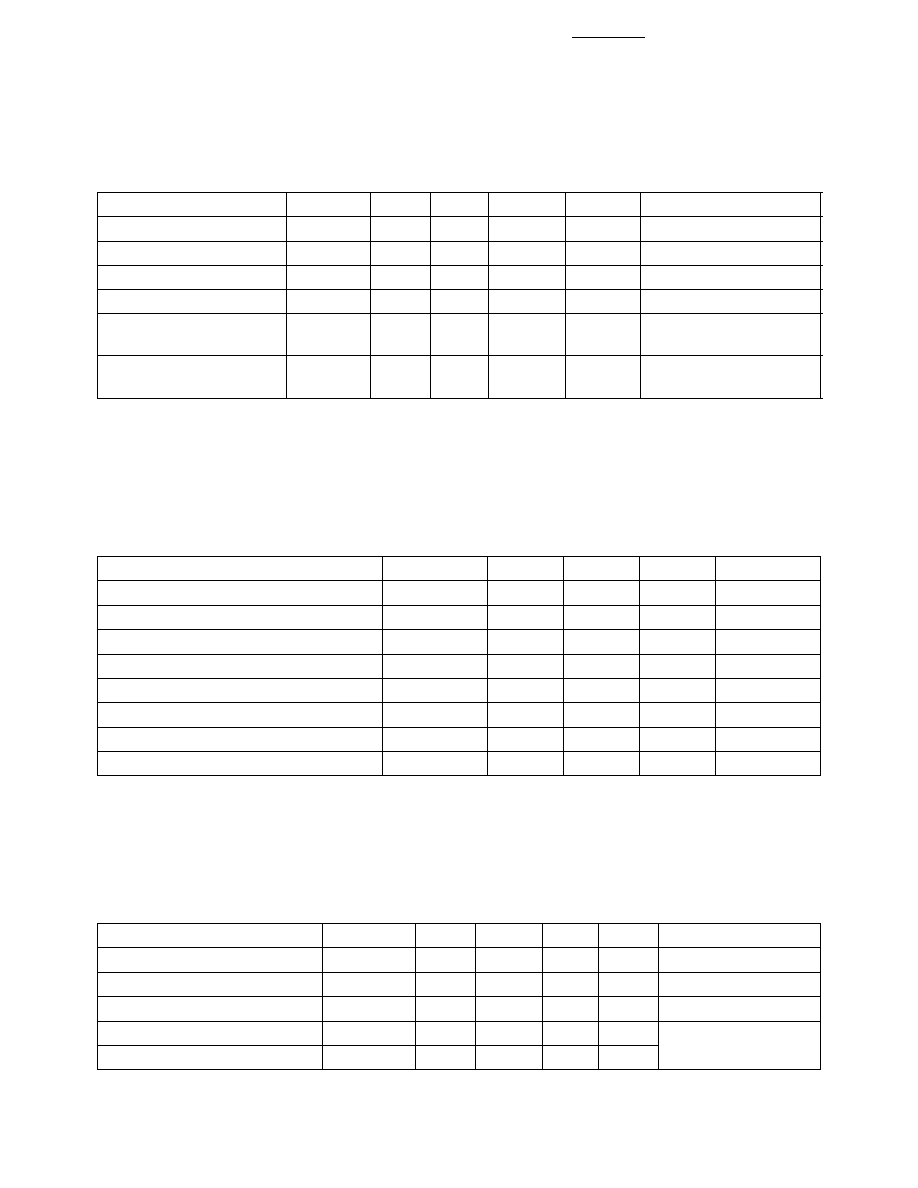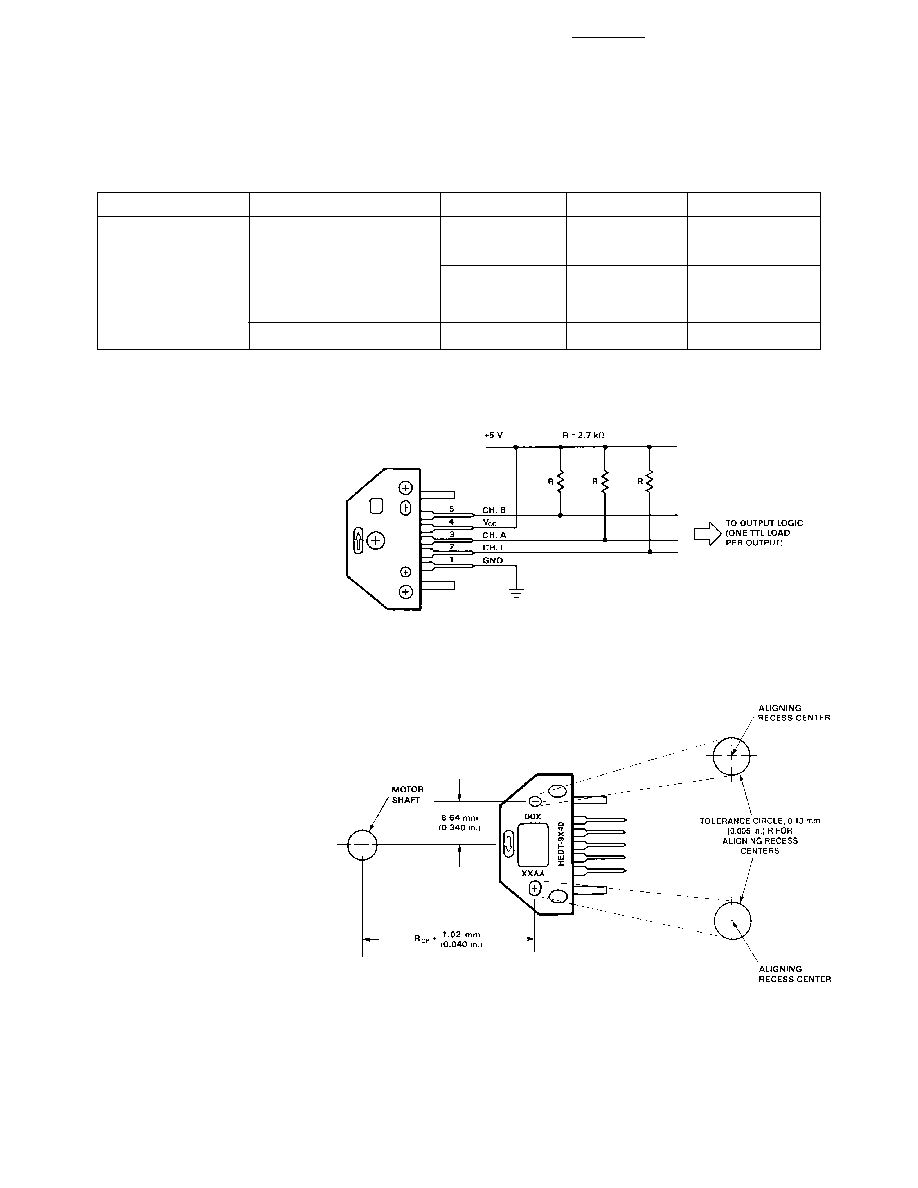 | –≠–ª–µ–∫—Ç—Ä–æ–Ω–Ω—ã–π –∫–æ–º–ø–æ–Ω–µ–Ω—Ç: HEDT-9040 | –°–∫–∞—á–∞—Ç—å:  PDF PDF  ZIP ZIP |

ESD WARNING: NORMAL HANDLING PRECAUTIONS SHOULD BE TAKEN TO AVOID STATIC
DISCHARGE.
High Temperature 140
Three Channel Optical
Incremental Encoder Modules
Technical Data
HEDT-9040
HEDT-9140
Features
∑ -40
∞
C to 140
∞
C Operating
Temperature
∑ Two Channel Quadrature
Output with Index Pulse
∑ Suitable for Automotive
Applications
∑ Resolution up to 1024
Counts per Revolution
∑ Low Cost
∑ Easy to Mount
∑ No Signal Adjustment
Required
∑ Small Size
Description
The HEDT-9040 and HEDT-9140
are high temperature three
channel optical incremental
encoder modules. When used with
a codewheel, these low cost
modules detect rotary position.
Each module consists of a lensed
LED source and a detector IC
enclosed in a small plastic
package. Due to a highly
collimated light source and a
unique photodetector array, these
modules provide the same high
performance found in the HEDS-
9040/9140 three channel
encoders.
Package Dimensions
∞
C
26.67 (1.05)
HEDS-9X40
15.2
(0.60)
CL
17.27
(0.680)
20.96
(0.825)
1.85 (0.073)
8.64 (0.340)
REF.
ALIGNING RECESS
2.44/2.41 DIA.
(0.096/0.095)
2.16 (0.085)
DEEP
1.02 ± 0.10
(0.040 ± 0.004)
5.1 (0.20)
X00
YYWW
OPTION CODE
0.63 (0.025)
SQR. TYP.
2.54 (0.100) TYP.
DATE CODE
1.0 (0.04)
3.73 ± 0.05
(0.147 ± 0.002)
2.67 (0.105) DIA.
MOUNTING THRU
HOLE 2 PLACES
2.44/2.41 X 2.79
(0.096/0.095 X 0.110)
2.16 (0.085) DEEP
OPTICAL CENTER
1.52 (0.060)
20.8
(0.82)
11.7
(0.46)
8.6 (0.34)
1.78 ± 0.10
(0.070 ± 0.004)
2.92 ± 0.10
(0.115 ± 0.004)
10.16
(0.400)
5.46 ± 0.10
(0.215 ± 0.004)
OPTICAL
CENTER LINE
2.54
(0.100)
2.21
(0.087)
5.8
(0.23)
6.35 (0.250) REF.
4.11 (0.162)
OPTICAL
CENTER
45∞
8.81
(0.347)
11.9
(0.47)
4.75 ± 0.01
(0.187 ± 0.004)
2.9
(0.11)
1.8
(0.07)
6.9 (0.27)
V
CC
GND
5 CH. B
4 V
CC
3 CH. A
2 CH. 1
1 GND
SIDE A
SIDE B
TYPICAL DIMENSIONS IN
MILLIMETERS AND (INCHES)

2
the adjacent pair of detectors. The
photodiode outputs are then fed
through the signal processing
circuitry resulting in A, A, B, B, I
and I. Comparators receive these
signals and produce the final
outputs for channels A and B. Due
to this integrated phasing
technique, the digital output of
channel A is in quadrature with
that of channel B (90 degrees out
of phase).
The output of the comparator for
I and I is sent to the index
processing circuitry along with
the outputs of channels A and B.
The final output of channel I is an
index pulse Po which is a one
state width (nominally 90
electrical degrees), high true
index pulse. This pulse is
coincident with the low states of
channels A and B.
Block Diagram
The HEDT-9040 and 9140 have
two channel quadrature outputs
plus a third channel index output.
This index output is a 90
electrical degree high true index
pulse.
The HEDT-9040 is designed for
codewheels which have an optical
radius of 23.36 mm (0.920 in.).
The HEDT-9140 is designed for
codewheels which have an optical
radius of 11.00 mm (0.433 in.).
The quadrature signals and the
index pulse are accessed through
five 0.025 inch square pins
located on 0.1 inch centers.
Resolutions between 360 and
1024 counts per revolution are
available. Consult local Agilent
sales representatives for other
resolutions.
Applications
The HEDT-9040 and 9140
provide high temperature motion
control detection at a low cost,
making them suitable for automo-
tive and industrial applications.
Note: Agilent Technologies
encoders are not recommended
for use in safety critical
applications. Eg. ABS braking
systems, power steering, life
support systems and critical care
medical equipment. Please
contact sales representative if
more clarification is needed.
Theory of Operation
The HEDT-9040 and 9104 are
emitter/detector modules.
Coupled with a codewheel, these
modules translate the rotary
motion of a shaft into a three-
channel digital output.
As seen in the block diagram, the
module contains a single Light
Emitting Diode (LED) as its light
source. The light is collimated
into a parallel beam by means of a
single lens located directly over
the LED. Opposite the emitter is
the integrated detector circuit.
This IC consists of multiple sets
of photodetectors and the signal
processing circuitry necessary to
produce the digital waveforms.
The codewheel rotates between
the emitter and detector, causing
the light beam to be interrupted
by the pattern of spaces and bars
on the codewheel. The
photodiodes which detect these
interruptions are arranged in a
pattern that corresponds to the
radius and design of the
codewheel. These detectors are
also spaced such that a light
period on one pair of detectors
corresponds to a dark period on

3
Cycle Error (
C):
An indication
of cycle uniformity. The differ-
ence between an observed shaft
angle which gives rise to one
electrical cycle, and the nominal
angular increment of l/N of a
revolution .
Pulse Width (P):
The number of
electrical degrees that an output
is high during 1 cycle. This value
is nominally 180
∞
e or 1/2 cycle.
Pulse Width Error (
P):
The
deviation, in electrical degrees, of
the pulse width from its ideal
value of 180
∞
e.
Definitions
Count (N):
The number of bar
and window pairs or counts per
revolution (CPR) of the
codewheel.
One Cycle (C):
360 electrical
degrees (
∞
e), 1 bar and window
pair.
One Shaft Rotation:
360
mechanical degrees, N cycles.
Position Error (
)
:
The
normalized angular difference
between the actual shaft position
and the position indicated by the
encoder cycle count.
Output Waveforms
State Width (S):
The number of
electrical degrees between a
transition in the output of channel
A and the neighboring transition
in the output of channel B. There
are 4 states per cycle, each
nominally 90
∞
e.
State Width Error (
S):
The
deviation, in electrical degrees, of
each state width from its ideal
value of 90
∞
e.
Phase (
):
The number of
electrical degrees between the
center of the high state of channel
A and the center of the high state
of channel B. This value is
nominally 90
∞
e for quadrature
output.
Phase Error (
):
The deviation
of the phase from its ideal value
of 90
∞
e.
Direction of Rotation:
When the
codewheel rotates in the direction
of the arrow on top of the
module, channel A will load
channel B. If the codewheel
rotates in the opposite direction,
channel B will lead channel A.
Optical Radius (R
OP
):
The
distance from the codewheel's
center of rotation to the optical
center (O.C.) of the encoder
module.
Index Pulse Width (P
o
):
The
number of electrical degrees that
an index is high during one full
shaft rotation. This value is
nominally 90
∞
e or 1/4 cycle.
Absolute Maximum Ratings
Storage Temperature, T
S
................................................. -40
∞
C to 140
∞
C
Operating Temperature, T
A
............................................. -40
∞
C to 140
∞
C
Supply Voltage, V
CC
............................................................ -0.5 V to 7 V
Output Voltage, V
O
.............................................................. -0.5 V to V
CC
Output Current per Channel, I
OUT
................................. -1.0 mA to 5 mA
Shaft Axial Play .................................................
±
0.25 mm (
±
0.010 in.)
Shaft Eccentricity Plus Radial Play ..................... 0.1 mm (0 004 in.) TIR
Velocity ........................................................................... 30,000 RPM
[1]
Acceleration ............................................................. 250,000 rad/sec
2[1]
Note:
1. Absolute maximums for HEDS-5140 codewheel only.

4
Electrical Characteristics
Electrical Characteristics over Recommended Operating Range.
Parameter
Symbol
Min.
Typ.*
Max.
Units
Notes
Supply Current
I
CC
30
57
85
mA
High Level Output Voltage
V
OH
2.4
V
I
OH
= -100
µ
A min.
Low Level Output Voltage
V
OL
0.4
V
I
OL
= 3.86 mA max.
Rise Time
t
r
90
ns
C
L
= 25 pF
Fall Time
t
f
80
ns
*Typical values specified at V
CC
= 5.0 V and 25
∞
C.
Recommended Operating Conditions
Parameter
Symbol
Min.
Typ.
Max.
Units
Notes
Temperature
T
A
-40
140
∞
C
Supply Voltage
V
CC
4.5
5.0
5.5
Volts
Ripple < 100 mV
p-p
Load Capacitance
C
L
100
pF
2.7 k
pull-up
Count Frequency
f
50
kHz
Velocity (rpm) x N/60
Shaft Perpendicularity
±
0.25
mm
6.9 mm (0.27 in.) from
Plus Axial Play
(
±
0.010)
(in.)
mounting surface
Shaft Eccentricity Plus
0.04
mm (in.)
6.9 mm (0.27 in.) from
Radial Play
(0.0015)
TIR
mounting surface
Note: The module performance is guaranteed to 50 kHz but can operate at higher frequencies.
Encoding Characteristics
Encoding Characteristics over Recommended Operating Range and Recommended Mounting Tolerances
unless otherwise specified. Values are for the worst error over the full rotation of HEDS-514X and HEDS-
6145 codewheels.
Parameter
Symbol
Min.
Typ.*
Max.
Units
Cycle Error
C
5
10
∞
e
Pulse Width Error
P
7
30
∞
e
Logic State Width Error
S
5
30
∞
e
Phase Error
2
15
∞
e
Position Error
10
40
min. of arc
Index Pulse Width
P
O
60
90
120
∞
e
CH. I rise after CH. B or CH. A fall
t
1
20
430
1490
ns
CH. I fall after CH. A or CH. B rise
t
2
40
250
620
ns
Note: Module mounted on tolerance circle of
±
0.13 mm (
±
0.005 in.) radius referenced from module Side A aligning recess centers. 2.7
k
pull-up resistors used on all encoder module outputs.
R
L
= 2.7 k
pull-up

5
Mechanical Characteristics
Part No.
Parameter
Dimension
Tolerance
Units
HEDS-5140
Codewheel Available
2
3
4
+0.000
mm
11.00 mm optical
to Fit These Standard
5
6
8
-0.015
radius codewheel
Shaft Diameters
5/32
1/8
+0.000
in.
3/16
1/4
-0.0007
Moment of Inertia
0.6 (8.0 x 10
-6
)
g-cm
2
(oz-in-s
2
)
Note: The tolerance requirements are on the mating shaft, not on the codewheel.
Electrical Interface
To insure reliable encoding
performance, the HEDT-9040 and
9140 three channel encoder
modules require 2.7 k
(
±
10%)
pull-up resistors on output pins 2,
3, and 5 (Channels I, A, and B) as
shown in Figure 1. These pull-up
resistors should be located in
close proximity of the encoder
module (within 4 feet). Each of
the three encoder module outputs
can drive a single TTL load in this
configuration.
Mounting Considerations
Figure 2 shows a mounting
tolerance requirement for proper
operation of the HEDT-9040 and
HEDT-9140. The Aligning Recess
Centers must be located within a
tolerance circle of 0.13 mm
(0.005 in.) radius from the
nominal locations. This tolerance
must be maintained whether the
module is mounted with Side A as
the mounting plane using aligning
pins (see Figure 5), or mounted
with Side B as the mounting plane
using an alignment tool (see
Figures 3 and 4).
Figure 1. Pull-up Resistors on HEDT-9X40 Encoder Module Outputs.
Figure 2. HEDT-9X40 Mounting Tolerance.




